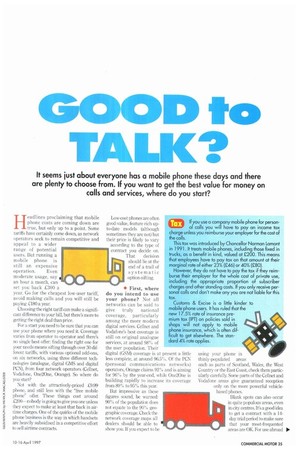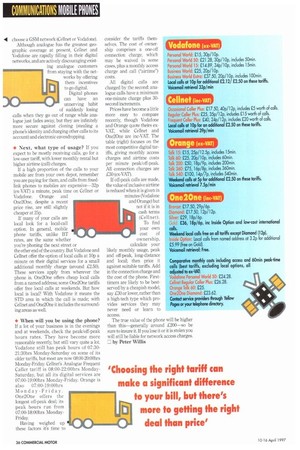H eadlines proclaiming that mobile phone costs are coming down are
Page 37

Page 38

If you've noticed an error in this article please click here to report it so we can fix it.
true, but only up to a point. Some tariffs have certainly come down, as network operators seek to remain competitive and appeal to a wider
range of potential users. But running a mobile phone is still an expensive operation. Even moderate usage, say an hour a month, can set you back 1:300 a year. Go for the cheapest low-user tariff, avoid making calls and you will still be paying £180 a year.
Chiming the right tariff can make a significant difference to your bill, but there's more to getting the right deal than price.
For a start you need to be sure that you can use your phone where you need it. Coverage varies from operator to operator and there's no single best offer: finding the right one for your needs means sifting through over 30 different tariffs, with various optional add-ons, on six networks, using three different technologies (analogue, digital GMS and digital PCN), from four network operators (Cellnet, Vodafone, One2One, Orange). So where do you start?
Not with the attractively-priced £9.99 phone, and still less with the "free mobile phone" offer. These things cost around C200—nobody is going to give you one unless they expect to make at least that back in airtime charges. One of the quirks of the mobile phone business is the way in which handsets are heavily subsidised in a competitive effort to sell airtime contracts. Low-cost phones are often good-value, feature rich upto-date models (although sometimes they are not) but their price is likely to vary according to the type of contract you decide on. That decision should lie at the end of a trail of systematic option-sifting.
• First, where do you intend to use your phone? Not all networks can be said to give truly national coverage, particularly among the more modern digital services. Cellnet and Vodafone's best coverage is still on original analogue services, at around 98% of the user population. Their digital (GSM) coverage is at present a little less complete, at around 96.5%. Of the PCN (personal communications networks) operators, Orange claims 92% and is aiming for 96% by the year-end, while One2One is building rapidly to increase its coverage from 80% to 95% this year.
But impressive as these figures sound, be warned: 90% of the population does not equate to the 90% geographic coverage. Check the network coverage maps all dealers should be able to show you. If you expect to be
using your phone in thinly-populated areas such as parts of Scotland, Wales, the West Country or the East Coast, check them particularly carefully. Some parts of the Cellnet and Vbdafone areas give guaranteed reception only on the more powerful vehiclebased phones.
Blank spots can also occur in quite populous areas, even in city centres. It's a good idea to get a contract with a 14day trial period to make sure that your most-frequented areas are OK. For use abroad II. choose a GSM network (Cellnet or Vodafone). Although analogue has the greatest geographic coverage at present. Cellnet and Vodafone are rapidly filling in their digital networks, and are actively discouraging existing analogue customers from staying with the networks by offering them incentives to go digital. Digital phones can have an unnerving habit of suddenly losing calls when they go out of range while analogue just fades away, but they are infinitely more secure against cloning (stealing a phone's identity and charging other calls to its account) and electronic eavesdropping.
• Next, what type of usage? If you expect to be mostly receiving calls, go for a low-user tariff, with lower monthly rental but higher airtime (call) charges.
If a high proportion of the calls to your mobile are from your own depot, remember you are paying for them, and calls from fixedlink phones to mobiles are expensive-32p (ex-VAT) a minute, peak time on Cellnet or Vodafone. Orange and One2One, despite a recent price rise, are still slightly cheaper at 25p.
If many of your calls are local look for a local-call
option. In general, mobile phone tariffs, unlike BT rates, are the same whether you're phoning the next street or the other end of the country. But Vodafone and Cellnet offer the option of local calls at 10p a minute on their digital services for a small additional monthly charge (around L2.50). These services apply from wherever the phone is. One2One offers cheap local calls from a named address; some One2One tariffs offer free local calls at weekends. But how local is local? With Vodafone it means the STD area in which the call is made; with Cellnet and One2One it includes the surrounding areas as well.
• When will you be using the phone? If a lot of your business is in the evenings and at weekends, check the peak/off-peak hours rates. They have become more reasonable recently, but still vary quite a lot. Vodafone still has peak hours of 07:3021:30hrs Monday-Saturday on some of its older tariffs, but most are now 08:00-20:00hrs Monday-Friday. C,ellnet's Analogue Frequent Caller tariff is 08:00-22:00hrs MondaySaturday, but all its digital services are 07:00-19:00hrs Monday-Friday. Orange is also 07:00-19:00hrs
Monday-Friday.
One2One offers the longest off-peak deal; its peak hours run from 07:00-18:00hrs MondayFriday.
Having weighed up these factors it's time to consider the tariffs themselves. The cost of ownership comprises a one-off connection charge, which may be waived in some cases, plus a monthly access charge and call ("airtime") costs.
All digital calls are charged by the second: analogue calls have a minimum one-minute charge plus 30second increments.
Prices have become a little more easy to compare recently, though Vodafone and Orange quote theirs exVAT, while Cellnet and One2One are inc-VAT. The table (right) focuses on the most competitive digital tariffs, giving monthly access charges and airtime costs per minute peak/off-peak. All connection charges are £30 (ex-VAT).
If off-peak calls are made, the value of inclusive airtime is reduced when it is given in minutes (Vodafone and Orange) but not if it is in cash terms (Cellnet). To find your own
cost of ownership, calculate your likely monthly usage, peak and off-peak, long-distance and local; then price it against suitable tariffs. Add in the connection charge and the cost of the phone. Firsttimers are likely to be bestserved by a cheapish model, say £30 or lower, rather than a high-tech type which provides services they may never need or learn to access.
The true value of the phone will be higher than this—generally around £200—so be sure to insure it. If you lose it or it is stolen you will still be liable for network access charges. CI by Peter Willis












































































































